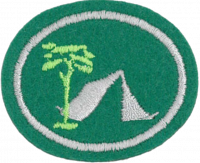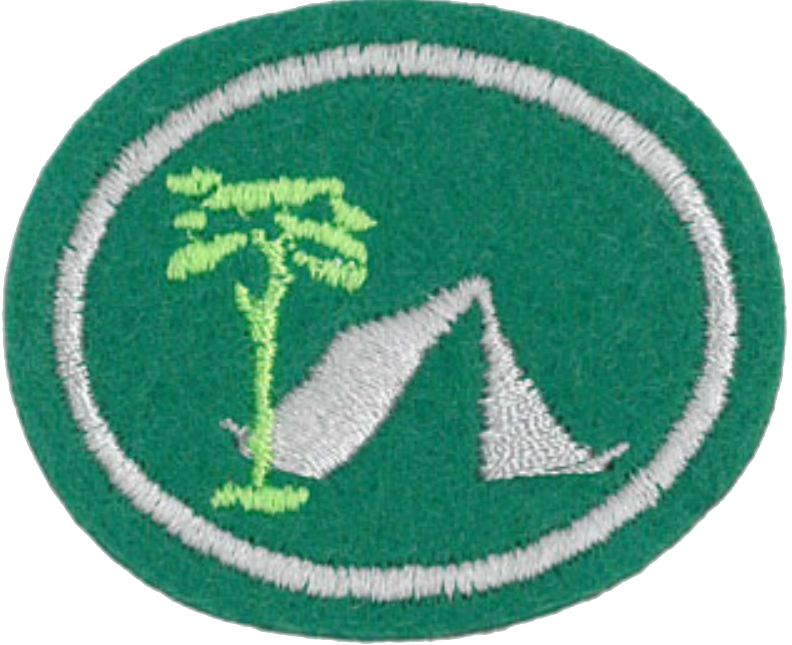AY Honor Camping Skills IV Answer Key
1
Camping Skills IV has been designed so that it is within the capabilities of Pathfinders who are in grade 8 or higher.
2
There are many ways to fulfill this requirement.
Themed Scavenger Hunt
A themed scavenger hunt is one option. Have your Pathfinders choose a theme, and then come up with as many items as they think can be found at your campsite and which relate in some way to the theme. Have them make a list of these items ahead of time, and hand the lists out when the activity begins. You may tell them that all the items relate to a theme, but do not tell them what the theme is. Give them 40 minutes to find all the items, and tell them to meet again at the end of that time period. When they return, ask them if they have guessed the theme. If they do not guess correctly, tell them what the theme is. Then have each Pathfinder working on the honor take turns calling for the items. When someone produces it, the Pathfinder will explain how that item relates to the theme. Be sure to draw a spiritual lesson from the activity. Close with a prayer.
Drawing or Photographing Nature
Many of the honors in the Nature category have the requirement to collect, photograph, or draw a number of creatures (plant or animal) found in nature, such as flowers, ferns, insects, etc. The Pathfinders presenting this activity should bring a field guide so that the chosen creatures can be identified. They may also bring samples of these items with them in case you are unable to find them around your campsite.
If you choose to have your Pathfinders sketch these items, be sure to bring enough notebooks and pencils (some honors require colored drawings - if so, bring colored pencils) for everyone. If you choose to have them take photos, you will probably want each Pathfinder to bring a camera (disposable cameras are ideal for this).
Collecting specimens is no longer encouraged, as it ends the life of the creature. Furthermore, many species are now endangered, and collecting them is not only unethical, it is illegal as well.
You can also mix photography and sketching. You may wish to have the group set out looking for specimens, and photograph all they can find. Then return and sketch the remainder. If you have only one or two cameras, you may find that this works well for you.
Skit with Props
Choose several Bible stories and divide your Pathfinders into at least two groups of three to eight individuals. Assign each group a Bible story and tell them where it may be found in the Bible. Have each come up with a skit to be presented to the rest of the group. Provide each group with random props and make it a contest between each group to see who can use the most of them. The props should be really off-the-wall so that the kids have to really think in order to use the item. Things like these do not have an obvious application, and that will make them stretch their imaginations:
- Ping pong paddle
- White board eraser
- Piece of fruit
- Cotton balls
- Measuring cup
- Toilet paper tube
- Ball of yarn
- A shoe
- Binder clip
- Ruler
- Compact Disc (blanks are cheap)
- Water bottle
Don't limit the props to this list or feel compelled to use anything on it - it's just a suggestion to get you started. See what you can find around the house, church, or campsite and press it into service for this activity. If possible, make each group's prop kit identical. Let everyone know how much time they have to put their skits together. Fifteen minutes should be sufficient. The remainder of the hour will be used to present the skits.
Hike
Go on a nature hike. Go along a stream and skip stones. Look for animal tracks and make plaster casts of them (your Companion class will thank you later).
Bible Quest
For this activity you will need to come up with several hiding places around the vicinity of the camp site and clues to each hiding place written on index cards. The cards are hidden. Each clue will direct the finder to the next clue (in other words, don't hide a clue at the location it hints at). Each clue should incorporate a passage from the Bible. For instance, the clue might say "Psalm 23:5, first part" which reads "You set a table before me in the presence of my enemies." This clue would direct the seekers to a picnic table where the next card is hidden. Another might hint "Psalm 119:105" which reads "Your word is a lamp to my feet and a light to my path." The clue could point the seeker to either the lantern (i.e., lamp) or to a path. They will have to check both places. It would be a good idea to bring a Concordance on this camping trip.
If you have a large group it would be better to make two copies of the cards, and make the clues circular (meaning that the last hiding place points back to the first hiding place). The first set is hidden around the camp site, one card per hiding place. The second set it handed out to the campers, one card per person, or per team (the teams should not have more than three people on them). That way everyone will start (and end) at a different point. If everyone starts at the same point, the campers with the strongest personalities will end up doing all the work and everyone else will just follow them - that's not fun. When the campers find their original clue, they have completed the quest.
When everyone is finished, ask them which one they liked the best, which one was hardest, easiest, etc.
3
Learning preservation, etiquette, and conservation is a requirement for Camping Skills I and II, so you can have the Pathfinders learning this honor review this material and present it to the younger ones.
Review and practice the Leave No Trace 7 Principles:
- Plan ahead and prepare.
- Travel and camp on durable surfaces.
- Dispose of waste properly.
- Leave what you find.
- Minimize campfire impacts (be careful with fire).
- Respect wildlife.
- Be considerate of other visitors.
© 1999 by the Leave No Trace Center for Outdoor Ethics
Be considerate of other campers. When purchasing tents, buy ones in muted colors that will blend in with the environment. If most of your camping is done at camp grounds frequented by others, blues, greens, and browns are preferred to reds and oranges. People go camping to escape the garishness of the city—leave that behind. However, if you camp in isolated places, bright and flashy colors make it easier to find your tent again if you leave it temporarily.
More importantly, when traveling in areas that allow hunting, wear bright colors such as orange to alert other's to your presence. An orange vest or hat is common.
Be mindful of the noise level made in your camp. Don't be a nuisance. If camping in the wilderness, be sure to make your camp out of sight of the trail. Most National Forests have guidelines for where you can camp in relation to the trail. Find out what those guidelines are and follow them.
Do not enter anyone else's camp site without their permission, especially when traveling to or from your campsite to other places on the campground. It is very rude to cut through another camp. Use the road or trail, even if it will take longer.
Leave the area cleaner than you found it If you are leading a group of youngsters on a campout, have a contest before you pile back in your cars to go home: see who can collect the most litter (define "most" first though - it can mean by volume, by weight, or by item count). Offer a prize to the one who collects the most (such as getting to choose which seat he or she will sit in on the trip home).
4
Use the USDA's food pyramid to choose a balanced menu: Adventist Youth Honors Answer Book/Camping/Balanced menu
Estimating the cost
To estimate the cost of the food on your menu, you will first need to estimate the quantity. This can be done with a spreadsheet, or by pencil and paper. First consider how much food your average camper will eat from each meal. Then figure out how much you will need for everyone to be able to eat the average amount. Some will eat more, but some will eat less. For example, if you are serving grilled cheese sandwiches, you will need two slices of bread and one slice of cheese per sandwich. Younger Pathfinders will usually eat two of these, but teens will easily eat three. Picky eaters may eat none or only one. It's up to you to guess how may each person will eat. Then multiply it out to see how many slices of bread you will need. There are usually 20 slices of bread in a loaf. Before figuring out how many loaves of bread you will need, make sure you consider every meal that will use bread (think French toast, PB&J, etc.). When you know the total number of slices you will need, then figure out how many loaves you will need. If your calculations show that you need 82 slices of bread, don't round it down to 80, or someone may not get a sandwich. Always round it up to the next loaf, so 82 slices will require five loaves of bread.
Do the same with each ingredient in your menu. The more you do this, the better your estimates will be. The goal is to come home with very little left over, as this will tell you that everyone got enough to eat, but you didn't waste money on food that will spoil anyhow.
5
6
7
Wood from conifers (pine, fir, spruce, etc.) contains a lot of highly flammable sap, so it burns both hot and quick. It is excellent for starting a fire. However, it does not leave a bed of coals, so it is unsuitable for cooking.
8
Most hardwoods will leave a good bed of coals, but hickory, mesquite, and oak, are among the best.
9
10
11
Of course you can make any dish you like for any of these, but we'll list suggestions anyhow. You can combine chili, kidney beans, and spaghetti to make Cincinnati Chili. Each camper starts with a layer of spaghetti, then adds a layer of chili, then a layer of beans. Chopped onions and cheese can also be added. It is delicious.
Soup
Template:Adventist Youth Honors Answer Book/Recipe
Template:Adventist Youth Honors Answer Book/Recipe
Vegetable
Most any vegetable can be prepared by heating it in a pot. This can be done over a campfire with a camp crane or with a camp stove.
- Kidney beans
- Green beans
- Corn on the cob (can be boiled or wrapped in foil and roasted in a campfire)
- Peas
Entree
Possibilities include
- Spaghetti
- Veggie Burgers
- Haystacks
- Veggie dogs
Drink
The drink must be "cooked" too, so try one of these (or something else)
- Hot chocolate
- Apple Cider
- Herb Tea
12
13
Note
| Color | AY Class | Honor |
| Blue | Friend | Camping Skills I |
|---|---|---|
| Red | Companion | Camping Skills II |
| Green | Explorer | Camping Skills III |
| Silver | Ranger | Camping Skills IV |


